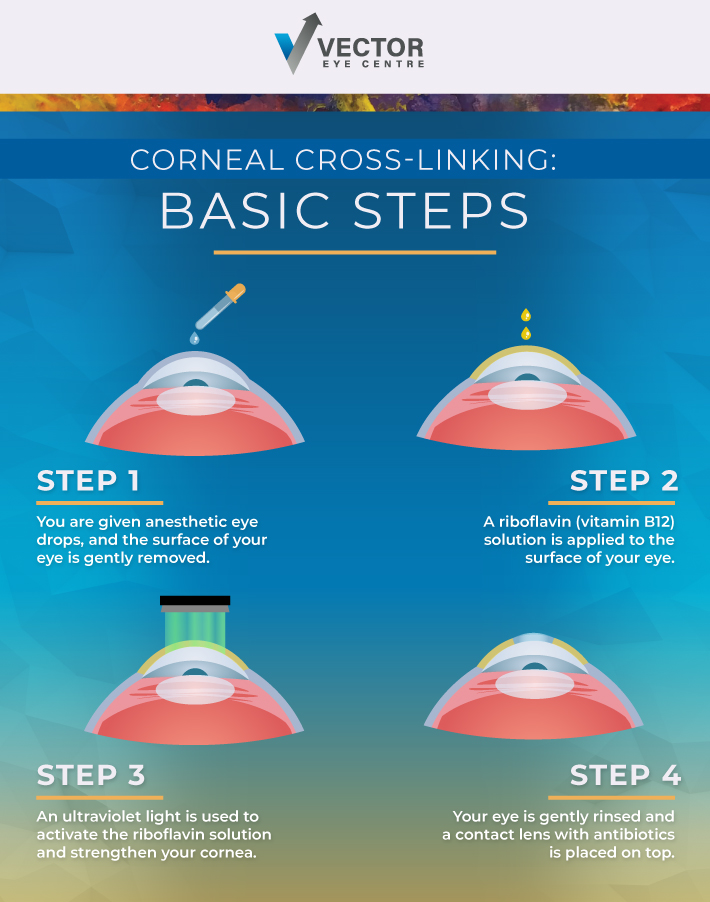Keratoconus is an ocular problem that can warp your cornea (clear part of the front of the eye) and progressively lead to vision loss if not treated. It’s often related to changes caused by slow changes leading to thinning, from an underlying disease and/or from excessive eye rubbing, of the connective tissue (called stroma) in the layers of your cornea.
Corneal cross-linking (CXL) is a safe procedure that can stop the cornea from changing by helping new collagen bonds form in your cornea, strengthening the tissue. For many of our patients, the cornea doesn’t just stop changing—it also gets a little bit better.
Corneal cross-linking can be life-changing for people with keratoconus, as it most often completely stops progression of keratoconus or corneal ectasia, preventing the need for cornea transplantation. Learning more about corneal cross-linking can help you determine if this procedure is something you want to consider.
How Does Corneal Cross-Linking Work?
Corneal cross-linking involves removing the top layer of the eye (the epithelial layer of the cornea) and exposing the inner stromal layers. The device used to remove the top layer is called an amoils brush—it sounds a bit like an electric toothbrush. The epithelium can also be loosened with a diluted safe alcohol solution and then gently rubbed off.
After removing the top layer of the eye, we apply riboflavin (vitamin B12) drops to the exposed stromal layers and activate them with an ultraviolet light. It takes about 15 minutes to complete these steps of the procedure.
At the end of the procedure, we gently rinse the surface of the eye with sterile water and then insert a contact lens with an antibiotic. We will also give you some pain medication and artificial tears to help you recover comfortably. The whole procedure, including the steps above, takes about 15–20 minutes.
This type of corneal cross-linking is known as epithelium off (or epi-off)—it’s the type covered by Alberta Health to qualifying patients. When treating the eye this way, there is over a 99% chance that the cornea cross-linking will go well and successfully stop the cornea from changing.

What Is the Recovery Like for Corneal Cross-Linking?
After your procedure, we continue to monitor your eye health and support your recovery. You’ll see us the next day, the next week, and then again after 3 months.
Immediately following your procedure, we’ll provide your medication and drops. Prior to the procedure you will receive comprehensive directions for all medications and other post-op instructions to support your recovery. During the first week, we also ask our patients not to drive, and to avoid watching TV or reading, using their phones, and using any other screens, as these activities lead to poor epithelial healing..
We know that’s a big change to ask for, but we find that people who make that change—and allow their eyes to rest—heal quickly, feel better faster, and have a reduced chance of scarring and infection.
With regular corneal cross-linking, the risk of infections and scarring is less than 1–2%. Since we’ve started asking our patients to let their eyes rest, we’ve noticed that this risk has gone down even further, and their recovery process has become more comfortable and efficient..
What Results Can You Expect from Corneal Cross-Linking?
The goal of corneal cross-linking is to stop changes in the cornea. It will not restore your vision to 20/20 vision. It keeps your cornea at its current shape—and maybe improves it a little. After the procedure, you will still need glasses or contact lenses to achieve the best possible vision.
In some cases, CXL is combined with other treatments that can improve the shape of your cornea, like PTK (phototherapeutic keratectomy). However, not everyone is ideally suited to that combination of procedures.
When you visit us, we will provide a consultation to help you determine what’s best for your vision—and provide specific, personalized information about the results you can expect from your procedure.
How Do You Know You Need Corneal Cross-Linking?
Corneal cross-linking is a procedure that you need to qualify for (coverage through Alberta Health Care is only available to qualifying patients). In order to qualify for this procedure, we need to be able to show that your cornea is continuing to change over time.
Prescriptions for glasses and contact lenses that continue to change over time are a good indication that your corneal condition is progressing. It’s also important to continuously monitor the shape of your cornea through a form of testing known as tomography. At our clinic, we use a device called The Pentacam for tomography.
Alberta Health Care does not cover tomography, but it is necessary to monitor changes in your cornea so we can plan whether you need a certain procedure, which procedure you might need, and when to do it.
What Can You Treat with Corneal Cross-Linking?
In addition to keratoconus, corneal cross-linking can also be used to treat:
- Pellucid marginal degeneration, another condition that causes your cornea to thin and bulge
- Ectasia (corneal thinning) caused by laser eye surgery complications
- Scarring from some cases of corneal ulcers
CXL might also be used to eliminate the need for corneal grafting or used with corneal grafting to stabilize the cornea.
Are There Other Options for Treating Keratoconus?
In some cases, we may recommend combining CXL with PTK. With this combination of treatments, PTK helps normalize the shape of your cornea, and then CXL helps stabilize it. Not everyone is a good candidate for this combined procedure—it depends on the shape of your cornea—and Alberta Health Care does not cover it.
For severe cases of keratoconus—such as those that have caused vision loss—we may recommend a corneal graft. A corneal graft involves using transplanted donor tissue to replace specific layers of your cornea. There are different types of corneal grafts, and the type we recommend will depend on the extent of the damage to your cornea.
Talk to Your Eye Doctor About Corneal Cross-Linking & Keratoconus
If you have keratoconus or have noticed changes in your vision that could be linked to keratoconus, it’s important to talk to your eye doctor. Through a referral to Vector Eye Centre, we can work with your eye doctor to determine the right option for preserving your vision.
Contact us today to learn more about visiting us for corneal cross-linking and other procedures.



